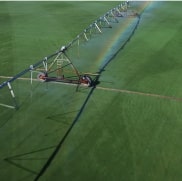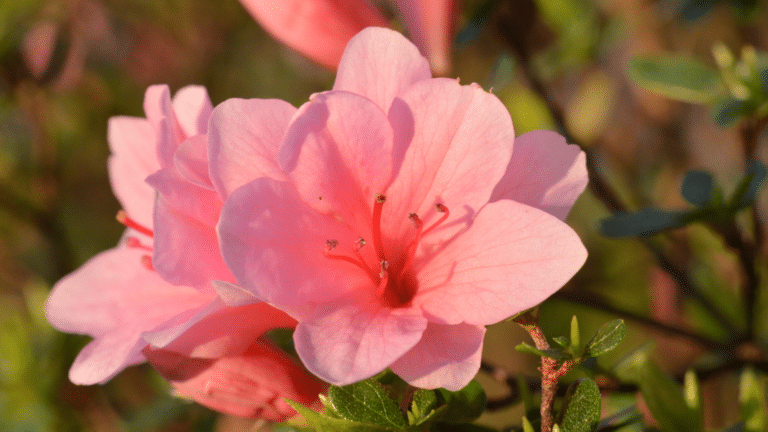The successful path to a healthy and vigorous lawn is to apply the key horticultural practices. Proper mowing, watering, feeding, aerification and top dressing, lawn repair and rejuvenation. Adhering to these practices will result in a lawn that will successfully compete with weeds, insects, disease, and climate issues.
Mowing
The golden rule for pruning is to cut no more than 1/3 of foliage for each mow. Mow according to the rate of grass growth. In Spring grass will grow faster than in a dry summer so you may mow more than once a week. Mow to a height of 2.5”-3” during most of the year. Weekly mowing also helps ensure that only a third of the foliage is removed. During little growth in summer raise height to 3”-3.5” if you let the lawn go dormant. This helps shade the turf plants and aids in holding more moisture in the crowns, soil, and root structure. At the end of the growing season (late September to October), lower the mowing height to 2”. This will help when mowing Fall leaves into small pieces to work into your lawn and feed the microorganisms. Do not rake leaves, compost them.
Clippings
Leave them. Clippings hold moisture and nitrogen, they are a natural fertilizer and do not lead to increased thatch. If clippings are clumped on the lawn, simply rake in.
Mowing problems – Mowing too short does not allow the plant adequate photosynthesis, causes stress, and makes it difficult for the turf to compete against weeds, insects, and disease. Mowing with dull blades – sharpening blades once a season will make clean cuts that heal quick, cause less browning on leaf tips, and creates less stress on the plants.
Watering
Water at the rate of 1”-1.5” of water when needed, no more than once a week. Know your soil, sandy requires more water, clay or hard soils will need soil amendments to help retain moisture. Pay attention to the amount of rainfall received. Water heavily and less often rather than frequent and short waterings. Shallow short watering leaves roots at the surface where they dry out faster. Deep watering brings deep roots that can withstand droughts and disease. Water at the rate of 1”-1.5” of water when needed, no more than once a week. If you let Mother Nature water, letting the lawn go dormant is fine, but if there is a 2–3-week period of no rain, then water .5”-1” to make sure the plant crowns and roots do not fail. Shallow containers such as tuna or cat food cans are good measuring tools placed on the lawn that your sprinkler pattern moves over. Cans are about 1.1/2” tall, measure the amount of time it takes to fill and know you know how long to water and how much.
Conserve water
Mow higher during dry times. Limit the use of area in dry times. Do not fertilize in Summer. When warm temperatures start, do not start to water till a mild drought, this will increase root growth. Remember turf does not grow past 85 degrees, so watering every 2-3 weeks will keep it dormant and prevent it from dying out.
Fertilization
The key components are nitrogen, phosphorus, potassium (NPK), and are always in that order regardless of brand. 6-4-0 represents the nutrients percentage by weight. Option of synthetic or organic fertilizers. Synthetic is quick release, plants absorb it with fast visual results. Fertilize first in late April when ground temperature and average day temperature are 50 –55 degrees. No summer application needed, excess nitrogen can burn the grass and increase/stimulate disease, weed and insect activity.
Organic fertilizer is long term, the nutrients stay in the soil until utilized but it is longer to see visible results. Organics feed the microorganisms in the soil creating a healthier more fertile soil. Milorganite is a great organic fertilizer. It is a slow release, so nutrients are in the soil when the plant needs it. Will not burn and is high in iron which results in a dark green color.
Fertilization schedule
Depending on your lawn health and climate, you can fertilize once a year to four times a year. 1st application is Spring or Memorial Day. 2nd application is Summer or July 4th. 3rd application is Fall or Labor Day. 4th application is Winter or Halloween.
The average lawn does not require four applications. If you need only one application, then apply in Fall, two applications – Spring/Fall, three applications – Spring/Fall/Winter.
Core aerification
Is considered by many to be the most important action one can take. Reduces soil compaction, encourages root development and new plants, helps maintain thatch, aids in the movement of water and oxygen to the roots, sets up the lawn for organic top dressing or overseeding. If the lawn is used frequently than aerate once a year in September or Spring. If it is sandy soil or not used, aerate every two to three years. 15 to 20 cores per sq.ft. Is the goal to make two crossing paths. Leave the cores, they will break down with mowing and irrigation.
Top dressing
After core aeration add 1/8” to ¼” compost and rake into the holes. This will add organic matter to the soil and improve the soil structure and drainage. Or you can use a compost tea liquid to add nutrition to the soil and leave the plugs to break down naturally.
Lawn repair and rejuvenation
Determine the cause of the decline or symptoms of what you see. Overly wet or dry soils, clay, compact soil, insects, climate affects, improper fertilization or mowing or watering, disease. Control can be dethatching, aerating, using gypsum, adding organic compost, using chemical control for insects or disease, overseeding, or pulling weeds. Thunderstorms (lighting) will “feed” the lawn during summer. Dethatching in spring “wakes up the lawn” by straightening matted crowns which allows air and sunlight to reach the ground surface.
Remember perfection of a lawn is an unreasonable expectation, it is ok to have a weed or two and insects, this is a natural habitat. A lawn is for aesthetics and recreation but also reduces temperatures and cleans the air by taking in carbon dioxide.










